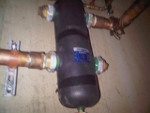Hydraulic Separator Connections
The Glitch
Over the last few years, we’ve discussed what hydraulic separators are for and how they should be installed. Specifically, I’ve described how a properly installed hydraulic separator provides not only hydraulic separation between the two hydronic circuits connected to it, but also provides excellent air and dirt separation as well. Thus, these are “triple function” devices.
Take a look at the photo of an installed hydraulic separator shown here (right). What’s wrong and how should it be connected?
The Fix
Although the hydraulic separator in the photo appears to be securely mounted, its piping is completely wrong. It appears that the installer was viewing this device as either an air separator or a dirt separator, but definitely not as a hydraulic separator. It can only act as the latter when there are two circuits piped through the device, each with their own circulator. The proper connection of a hydraulic separator is shown here (right).
It’s important to pipe the hot water from the heat source through the upper connections on the hydraulic separator. This enhances its ability for air removal. Likewise, the return from the distribution system and the heat source should always go through the lower connections. This enhances dirt separation.
To summarize, the connections to a hydraulic separator are not open to “interpretation.”
If all else fails, read the installation instructions...
Links
Looking for a reprint of this article?
From high-res PDFs to custom plaques, order your copy today!








